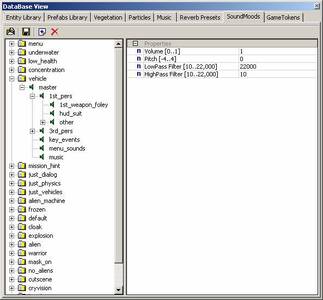Sound Moods
Properties

Moods
Think of moods as a level of intensity. Moods do not have to have unique names. Since moods are used by music logic to transition between different intensities in one theme, it is necessary to have a similar collection of moods in each theme. Moods are made up of a set of patterns. A mood must have a Main layer. This is a looping piece of music. Often a mood can have Start and End layers. The Start and End are optional patterns designed to be stuck on the front or back of a looping piece to create graceful endings and beginnings. There is also an incidental layer which plays short pattern on top of a looping piece. This can add variety to your music. Finally there is a stinger layer. Music Logic will play a stinger when moving from Incidental to Ambient mood.
Mood Properties
Fade out time
how long it takes to fade the current mood when switching to a new one
Play Single
this will force a mood to play once, and not loop.
Main Layer pattern properties
Filename: this is the looping music audio file. Fadepoints: this is a comma delimited list of sample points where a mood can fade from one to the next. I.e. If a signal is given to switch moods, the music system will wait until a fade point is reached to do so. The peak of the crossfade is at that fade point. This means the new mood will fade in to maximum volume when it reaches the fade point at which point the old mood will begin to fade out.
Pre-FadeIn
Number of sample the new mood uses to fade in. Volume: Loudness is controlled at the pattern level. 0.0 to 1.0 for full volume. Probability: You can have multiple patterns in a layer. The music system will choose a random pattern weighing this value.
Start Layer
If a start layer is present, the music system will choose to play this then seamlessly attach the main layer after it.
End Layer
When ending a piece of music, the music system will play the end pattern when it has reached the end of the main pattern. Note: There is also a flag in the
MusicEndTheme entity to jump from a fade point to the end pattern. This way, a Theme could be ended quickly and gracefully.
Incidental Layer
These are patterns which will play at random synchpoints, in time with the main layer. Typically used as embellishments to a consistent loop. The Incidental Layer has a probability which is how likely one of its patterns will play when a synchpoint is reached. There is also a probability setting for each pattern, so patterns can be weighted differently.
Stinger Layer
Similar to indiental patters; however, Stingers are played by
MusicLogic irrespective of synchpoints, ie. Not in time with the main layer. Currently
MusicLogic calls one anytime a theme switched from the incidental to ambient mood.
Patterns
All patterns must have a unique name. The music system must be able to differentiate between patterns. A pattern can be used either as a one-shot piece of music or as part of a more complex piece of music. It is at the pattern level where the specific audio file is listed. The music system does not play sound events, it plays audio files directly.
Filename
Click on the folder icon to open the sound browser, then click browse file to select an audio file.
Fade Points
Fadepoints are measured in samples. Each fade point is a sample value separated by a comma with no space.
Pre-FadeIn
This is the number of samples before a fade point when a pattern begins to fade in.
Volume
Measured from 0.0 to 1.0. Other than global music volume, this is the only place music volume can be set.
Probability
When there is more than one pattern in a layer, this value gives each pattern its own likelihood of playing.
